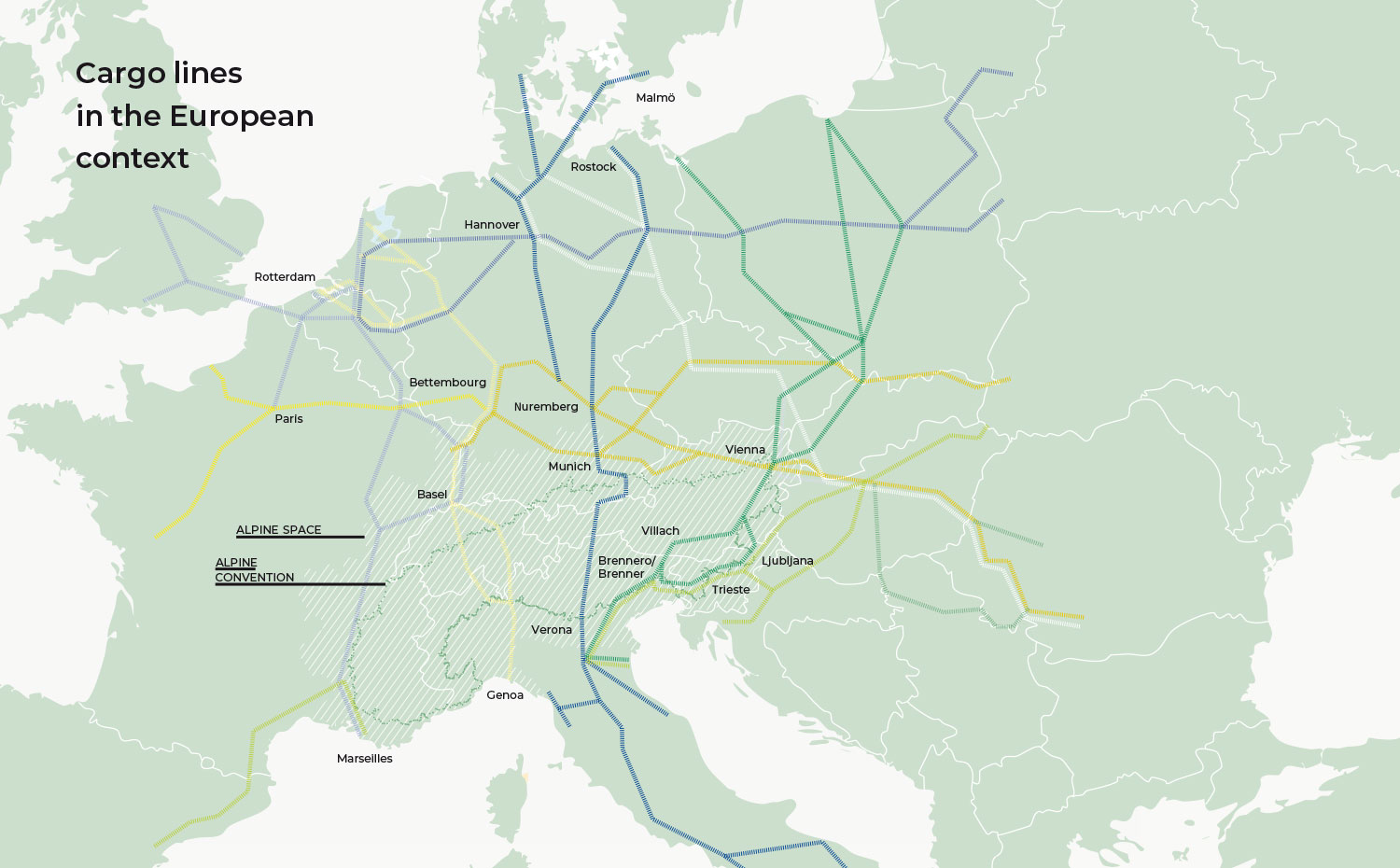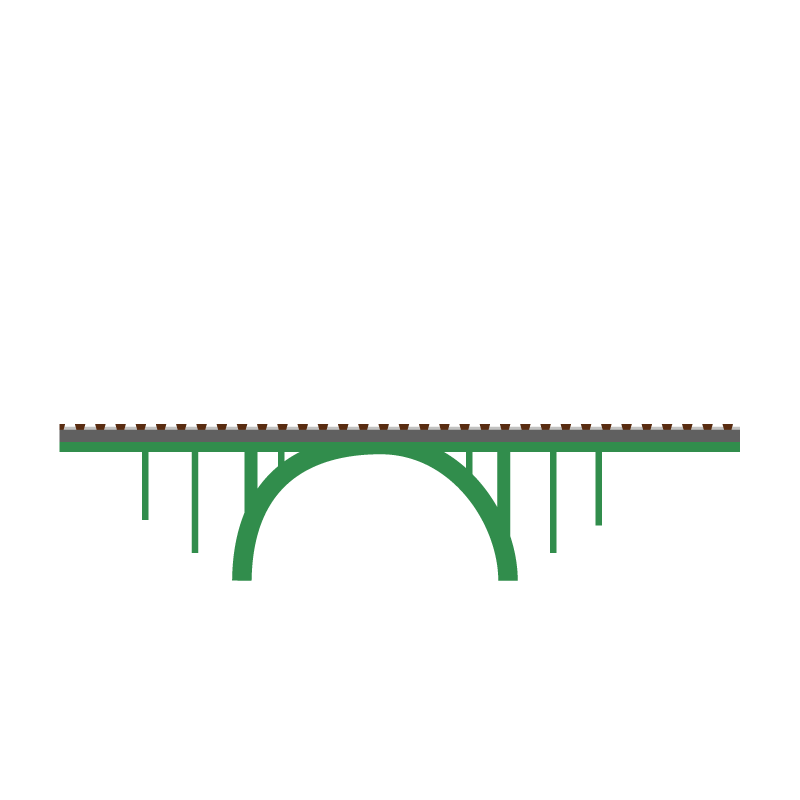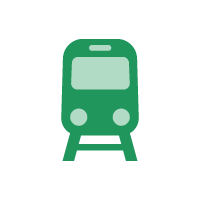BACKGROUND
BACKGROUND
BACKGROUND
Combined Transport – a sustainable alternative to road freight transport
Introduction

The Alps are crossroads for goods transport and they are essential for the economic development in the European Union and the Alpine Space. Each year around 40 million tons of goods are transported through this precious mountainous landscape. About one third of this is carted by lorry such that transport is a main source for pollutant emissions as well as noise pollution. The Alps as a sensitive ecosystem thus need further protection.
To reconcile the volume of the goods transport with the protection of nature & people, it was decided in the EU White Paper 2011 to strengthen intermodal transport & to establish more efficient freight transport corridors in the Alps. Also, the EU strategy for the Alpine Space (EUSALP) required a change towards an improved inter-modality for freight transport across the Alps to become more sustainable and to minimize the transports’ negative impacts on the climate and the environment. In this context Combined Transport (CT) can be an ideal approach — by shifting the transport of goods from road to rail. Yet, currently CT is not able to compete with road transport due to various challenges: low sensitization, information deficit, lacking of internalization of external costs for road freight, minimal automation, lack of communication, rigid systems etc. Thus, the main challenge is to raise efficiency, competitiveness & productivity of CT compared to road freight transport together with all relevant stakeholders at transnational level.
The AlpInnoCT (Alpine Innovation for Combined Transport) project contributes to the above mentioned goals by trying to achieve a more efficient CT in the mid- and long-term and to elaborate scenarios for CT in the Alpine Space after 2030. It also plays into the EUSALP goal “Better overall transport system in terms of sustainability & quality/sustainable accessibility to the Alps by raising railway attractiveness & utilization”. The project is supported by a wide number of stakeholders in the CT sector including 40 observers. The whole project consortium (comprising of 15 partners) has formulated recommendations for an ideal CT-model that takes into account expertise and guidelines from the industrial sector (based on benchmarks) for transferring innovative approaches to daily CT business and to increase CT productivity. The consortium also established Alpine-wide dialogue platforms and transnational cooperation between enterprises, political administration and the civil society to put forth the so called “toolbox of action” — which summarises political and technical recommendations on how to foster CT in the Alpine Space.
Hence, AlpInnoCT aimed at establishing a more efficient Alpine freight transport with focus on CT to be able to also contribute to EUSALP goals. This means CT processes shall be organised in a more productive and better coordinated way on an international level. By an enhanced cooperation between stakeholders, specific information, awareness, access and use of this low-carbon transport method is raised significantly. Finally, considerable freight volumes can be shifted to rail.
a sustainable alternative to road freight transport

TRANSPORT
Transport is recognized as an opportunity for the economic development of contemporary society, but at the same time it is one of the main causes of social and environmental negative externalities (such as air pollution, noise, accidents, congestion), which have been estimated at 4% of the EU Gross Domestic Product. This is particularly valid for those areas – such as the Alpine Space – that are fragile from an environmental and social point of view. For this reason, the aim of EU policies is to encourage those vehicles that produce fewer negative impacts on the territories crossed.

THE MAIN ROAD INFRASTRUCTURES
Most of the current transalpine freight (68% in 2017) is performed by Heavy Goods Vehicles, which run along the main road infrastructures without sufficient internalisation of external costs, instead producing negative impacts on the territories crossed. Only one third of freight is transported by rail (considered in all its forms: conventional, unaccompanied and accompanied combined transport). This condition constitutes a criticality for the entire society, which needs to be addressed.

COMBINED TRANSPORT (CT)
Combined Transport (CT), i.e. the Combined Transport is by definition intermodal transport where the major part of the European journey is by rail, inland waterways or sea and any initial and/or final legs carried out by road are as short as possible. Intermodal transport is the movement of goods in one and the same loading unit or road vehicle, which uses successively two or more modes of transport without handling the goods themselves in changing modes. The combination of road-rail is the most relevant for the Alpine Space. Efficient infrastructural equipment, composed of linear infrastructures (road and rail) and intermodal terminals (nodes equipped for the transshipment and storage of goods), is the precondition for a proper function.

CT PRESENTS SEVERAL BENEFITS
Given such premises, CT presents several benefits: it merges the strengths of road and rail transport, using the area-wide flexibility of the trucks combined with the reliability and the economies of the train on long journeys. Furthermore, CT is environmentally friendlier, with lower CO2, PMX and NO2 emissions compared to roads. It also has a lower impact on society, as it reduces accidents, road congestion and dependency on energy reserves. Referring to the management of the service, CT allows a better use of capacity in existing infrastructures. In terms of spatial development, a limited number of linear and punctual infrastructures (concentrated in selected points) implies the need for fewer areas and consequently the preservation of more undeveloped land.

CT HAS CERTAIN WEAKNESSES
On the other hand, CT has certain weaknesses that prevent its wider diffusion (see the next section for further details): it may be more expensive than road transport (especially in the first- and last-mile legs), the average times required to provide the service can be higher and the difficulties in the harmonization of the service between countries are numerous.

THE IMPROVEMENT OF CT
There are many possibilities for the improvement of CT, thus making it more competitive and more likely to be used in the Alpine context. However, even if not all freight transported by road may be transferred to rail, reducing the road pressure along transalpine axes represents a target that has to be reached in order to guarantee more balanced modal distribution and, ultimately, more sustainable transport in Europe.
Challenges
for Combined Transport in the Alps
Despite the positive aspects highlighted in the previous paragraph, in 2017 Combined Transport (CT) constituted only 17% of total freight transported in the Alps (15% for unaccompanied and 2% for accompanied CT). The reasons for this situation are multiple. They may be divided into three main groups:

The infrastructural equipment is the main aspect related to this situation. Linear infrastructures (i.e. high-speed/high-capacity railway lines) need to be conceived as an integrated network, able to guarantee competitive transport between the main nodes. Currently, several initiatives are under development (e.g. the construction of the Brenner Base Tunnel along the Brenner corridor) to make transalpine railway transport more appealing, but in some cases existing lines are inadequate (with constraints related to the loading gauge, the weights that can be transported and the commercial speed of trains). As regards the commercial speed, along some international routes this is close to 20 km/h; along the Brenner line, the maximum speed between some stretches between Bolzano and the Brenner Pass is 60 km/h. There are conflicts between passenger and freight transport in that passenger transport in most cases has priority. This also influences the performance of freight trains. Moreover, the differences in energy and signalling systems in the EU represent two other relevant infrastructural elements. As regards the former, the 15 kV system used in Austria, Germany and Switzerland is different from the 3 kV system used in Italy or Slovenia or the 1.5 kV system in France: these differences imply in most cases a change of the locomotive, which contributes to an increase in transportation time. Secondly, the signalling systems: any locomotive entering a country must be equipped with the national signalling system on board. ERTMS is able to overcome this condition, but its development is slow. Punctual infrastructures such as intermodal terminals also represent critical aspects. The low density of CT terminals may determine high costs for pre- and on-carriage by road, handling costs, deficits in service quality and cost efficiency. On the other hand, some main intermodal terminals are close to saturation, which makes operational aspects (transhipment, storage) more complicated and subject to unexpected events that may generate delays in the departure/arrival of freight.

The management of the CT service is a second main challenge. Since CT involves a plurality of actors, the coordination between infrastructure managers and carriers for railway undertakings and service providers is essential, but often complicated because of the lack of standardization of the technical aspects and administrative procedures. This results in delays or higher costs for the final users. The lack of harmonization in rail service constitutes another main issue. It may be related to numerous aspects such as train numbering, train path definition, handover procedures at borders, exchange of operational data, or train monitoring. In Italy, for instance, two locomotive drivers are required, whereas in most European countries just one is sufficient. Since transalpine transport includes trips where Italy is either the origin or destination of the journey, this aspect has a direct impact on transalpine CT. Besides that, in contrast to aviation where English is the official language, locomotive drivers need to be able to communicate in the language of the country in which the train is travelling. This may be a challenging condition, when transnational journeys (like the transalpine ones) are considered.

Finally, several challenges related to the service have to be recalled. The cost of road first and last mile is high, as well as the cost for short-distance transport (CT is usually considered economically more competitive with road transport for distances over 300km). The access to rail markets is different in each country: this makes the liberalization of the service (which contributes to the increase of competitiveness) more complicated. Further, the CT rail/road sector lacks an open data ICT platform (Information and communication technology) for exchanging booking, operational, tracking and tracing data between relevant companies involved in the CT supply chain, which would make the service more easily manageable.
These and other aspects, about which interested readers may discover more in reports of AlpInnoCT, help explain the main challenges that CT has to face to become more competitive and reduce the road pressure along the main transalpine axes.
These and other aspects, about which interested readers may discover more in reports of AlpInnoCT, help explain the main challenges that CT has to face to become more competitive and reduce the road pressure along the main transalpine axes.
Future Outlook
Initiatives promoting Combined Transport
To improving CT several activities are needed. A review of past and current operational and technical initiatives was elaborated. The analysis showed that these activities propose solutions to foster CT through the following items:

Digitalization of logistic information of all actors, supported by several legislation frameworks. On operational level a focus is put on sharing estimated arrival time and real time information for intelligent (smart) planning, management, monitoring and maintenance of transport assets and communication technologies in order to provide better CT service also to the end users.

Automatization of rail freight (autonomous trains, future wagons, future locomotives, future terminals, automatic train operations including moving block, and coupling).

Integrated corridor approach with synergic interventions of design of CT infrastructure, innovative technologies, activities to advance digitalization and integrated timetable planning.

Reorganization of freight logistic structures (also for implementation of innovative technologies)

End user view implementing “just in time” concepts, cash-to-cash cycle models and synchro-modality.

Education of and knowledge transfer between trainees, teachers and decision makers with regard to different instruments in CT management.

Central project management for operation and infrastructure with clear responsibilities for freight network, reasonable allocation of port resources, sharing local business and operational innovative solutions as well as integrated view of risks and threats for different assets in CT.

Lean Management of CT assets through Conditionbased Monitoring, Predictive Maintenance, BIM (Building Information Modelling) and selection of lightweight and noise abatement material, and CT operation through industry optimization methods.

Long-term measures increasing CT supply allowing to operate a 4 m gauge corridor, 1500 m long trains and higher frequency of CT trains.
Future initiatives should tackle solutions for alternative routes and 24/7 opening times of shippers/warehouses, depots and work- shops as well as more reliable slots for freight trains and political solutions for faster customs clearance, stimulations for lower prices of rail and for developing standards for ILU check (trains and truck check-in) with standardized documents.
Additionally, the review showed the need for developing a platform providing a comprehensive overview of initiatives fostering Combined Transport through research and development projects, implementations, in- novative technologies, theoretical concepts, NGO’s and legal frameworks with push and pull measures per country and region.